
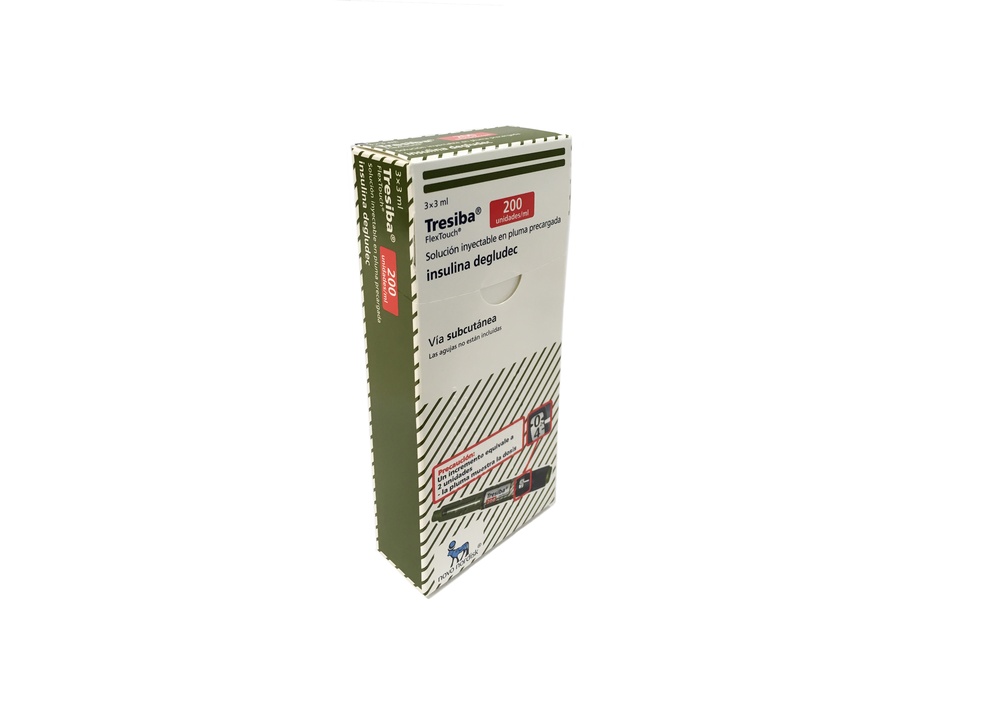
TRESIBA 200 Units/mL FlexTouch pre-filled pen solution for injection

Ask a doctor about a prescription for TRESIBA 200 Units/mL FlexTouch pre-filled pen solution for injection

How to use TRESIBA 200 Units/mL FlexTouch pre-filled pen solution for injection
Introduction
Package Leaflet: Information for the Patient
Tresiba 200units/ml FlexTouch solution for injection in pre-filled pen
insulin degludec
Read all of this leaflet carefully before you start using this medicine because it contains important information for you.
- Keep this leaflet, you may need to read it again.
- If you have any further questions, ask your doctor, pharmacist or nurse.
- This medicine has been prescribed for you only. Do not pass it on to others. It may harm them, even if their signs of illness are the same as yours.
- If you get any side effects, talk to your doctor, pharmacist or nurse. This includes any possible side effects not listed in this leaflet. See section 4.
Contents of the pack and other information
- What is Tresiba and what is it used for
- What you need to know before you use Tresiba
- How to use Tresiba
- Possible side effects
- Storing Tresiba
- Contents of the pack and further information
1. What is Tresiba and what is it used for
Tresiba is a long-acting basal insulin called insulin degludec. It is used in adults, adolescents and children from 1 year of age to treat diabetes mellitus. Tresiba helps your body to lower your blood sugar level. It is used once a day. When you cannot follow your usual administration time, you can vary the administration time because Tresiba has a long-lasting blood sugar lowering effect (see section 3, “Flexibility in dosing schedule”). Tresiba can be used with rapid-acting insulins administered in relation to meals. In patients with type 2 diabetes mellitus, Tresiba can be used in combination with diabetes tablets or with non-insulin injectable antidiabetics.
In patients with type 1 diabetes mellitus, Tresiba must always be used in combination with rapid-acting insulins administered in relation to meals.
2. What you need to know before you use Tresiba
Do not use Tresiba
- if you are allergic to insulin degludec or any of the other ingredients of this medicine (listed in section 6).
Warnings and precautions
Talk to your doctor, pharmacist or nurse before you start using Tresiba. It is important that you know the following:
- Low blood sugar (hypoglycaemia) – If your blood sugar is too low, follow the instructions in section 4.
- High blood sugar (hyperglycaemia) – If your blood sugar is too high, follow the instructions in section 4.
- Change from other insulins – You may need to adjust your insulin dose if you change from another type, brand or manufacturer of insulin. Talk to your doctor.
- Use of Pioglitazone with insulin – See the section on “Pioglitazone” below.
- Vision problems – A sudden improvement in blood sugar control may cause a temporary worsening of diabetic eye problems. If you experience any problems with your eyes, talk to your doctor.
- Using the correct insulin – Always check the label of your insulin before each injection to avoid mix-ups between the different Tresiba strengths and other insulins.
In case of reduced vision, see section 3.
Changes at the injection site
You should rotate the injection site to help avoid changes in the fatty tissue under the skin, such as thickening of the skin, shrinking of the skin or lumps under the skin. Insulin may not work well if you inject into a lumpy, shrunk or thickened area (see section 3 “How to use Tresiba”). Tell your doctor if you notice any changes at the injection site. Tell your doctor if you are currently injecting into these affected areas, before you start injecting into a different area. Your doctor may tell you to check your blood sugar more often and adjust your insulin or the dose of your other antidiabetic medications.
Children and adolescents
Tresiba can be used in adolescents and children from 1 year of age. There is no experience with the use of Tresiba in children below 1 year of age.
Other medicines and Tresiba
Tell your doctor, pharmacist or nurse if you are using, have recently used or might use any other medicines. Some medicines affect your blood sugar level, and your insulin dose may need to be changed.
The following are the main medicines that may affect your treatment with insulin.
Your blood sugar may fall (hypoglycaemia) if you take:
- other medicines for diabetes (oral and injectable)
- sulphonamides, for treating infections
- anabolic steroids, such as testosterone
- beta-blockers, for treating high blood pressure. These may make it harder to recognise the warning signs of a low blood sugar (see section 4 “Warning signs of low blood sugar”)
- acetylsalicylic acid (and other salicylates), for pain and low-grade fever
- monoamine oxidase inhibitors (MAOIs), for treating depression
- angiotensin-converting enzyme (ACE) inhibitors, for treating certain heart conditions or high blood pressure.
Your blood sugar may rise (hyperglycaemia) if you take:
- danazol, for treating endometriosis
- oral contraceptives (birth control pills)
- thyroid hormones, for treating thyroid problems
- growth hormone, for treating growth hormone deficiency
- glucocorticoids, such as cortisone, for treating inflammation
- sympathomimetics, such as adrenaline (epinephrine), salbutamol or terbutaline, for treating asthma
- thiazides, for treating high blood pressure or if your body is retaining too much fluid.
Octreotide and lanreotide: used for the treatment of acromegaly, a rare disorder characterised by excessive production of growth hormone. These medicines may increase or decrease your blood sugar levels.
Pioglitazone: oral antidiabetic used for the treatment of type 2 diabetes mellitus. Some patients with type 2 diabetes mellitus of long standing and heart disease or previous stroke who were treated with pioglitazone and insulin developed heart failure. Tell your doctor immediately if you have signs of heart failure such as unusual shortness of breath, rapid increase in weight or localised swelling (oedema).
If you are in any of the above situations (or are unsure), talk to your doctor, pharmacist or nurse.
Using Tresiba with alcohol
If you drink alcohol, it may alter your insulin need as your blood sugar level may increase or decrease. Therefore, you should monitor your blood sugar level more often than usual.
Pregnancy and breast-feeding
If you are pregnant or breast-feeding, think you may be pregnant or are planning to have a baby, ask your doctor or pharmacist for advice before using this medicine. You may need to adjust your insulin dose during pregnancy and after delivery. During pregnancy, it is essential to maintain good control of your diabetes. Avoiding low blood sugar (hypoglycaemia) is especially important for the health of your baby.
Driving and using machines
Low or high blood sugar levels may affect your ability to drive or use machines. If your blood sugar is too low or too high, your ability to concentrate and react may be impaired. This could put you or others at risk. Ask your doctor if you can drive:
- if you have frequent episodes of low blood sugar;
- if you have difficulty recognising the warning signs of low blood sugar.
Important information about some of the ingredients of Tresiba
This medicine contains less than 1 mmol sodium (23 mg) per dose, i.e. it is essentially “sodium-free”.
3. How to use Tresiba
Follow exactly the instructions for administration of this medicine given by your doctor. If you are not sure, talk to your doctor, pharmacist or nurse.
If you are blind or have reduced vision and cannot read the dose counter on the pen, do not use this pen without help. Ask for assistance from a person with good eyesight who is trained in the use of the pre-filled FlexTouch pen.
Tresiba in pre-filled pen is available in two strengths. “Tresiba 100 units/ml” or “Tresiba 200 units/ml” which is clearly indicated on the label of the pen and on the carton. In addition, the carton and label of Tresiba 100 units/ml are light green and the carton and label of Tresiba 200 units/ml are dark green with stripes and a red box highlighting the strength.
For both strengths, you select the dose in units. However, the dose units vary between the two Tresiba strengths.
The pre-filled pen of 200 units/ml can deliver a dose of 2-160 units in one injection, in increments of 2 units. The dose counter on the pen shows the exact number of units of insulin to be injected. Do not perform any dose calculations.
Your doctor will decide with you:
- how much Tresiba you will need each day
- when to check your blood sugar and if you need a higher or lower dose.
Flexibility in dosing schedule
- Always follow your doctor’s recommendations.
- Use Tresiba once a day, preferably at the same time every day.
- On occasions when you cannot use Tresiba at the same time of the day, you can use it at a different time of the day. Make sure that at least 8 hours pass between doses. There is no experience with the flexibility in dosing schedule of Tresiba in children and adolescents.
- If you want to change your usual diet, talk to your doctor, pharmacist or nurse, as a change in your diet may alter your need for insulin.
Depending on your blood sugar level, your doctor may change your dose.
When using other medicines, ask your doctor if you need to adjust your treatment.
Use in elderly patients (≥65 years)
Tresiba can be used in elderly patients, but if you are elderly, you may need to check your blood sugar more often. Talk to your doctor about possible changes in your dose.
If you have kidney or liver problems
If you have kidney or liver problems, you may need to check your blood sugar more often. Talk to your doctor about possible changes in your dose.
Injecting the medicine
Before using Tresiba for the first time, your doctor or nurse will show you how to use the pre-filled pen.
- Check the name and strength on the label of the pen to ensure it is Tresiba 200 units/ml.
- The dose counter on your pen shows the exact number of units of insulin. Do not recalculate the dose.
Do not use Tresiba
- in insulin infusion pumps.
- if the pen is damaged or has not been stored correctly (see section 5 “Storing Tresiba”).
- if the insulin does not look like water and is not clear.
How to inject yourself
- Tresiba is injected under the skin (subcutaneously). Do not inject into a vein or muscle.
- The best injection sites are the front of your thighs, the upper arms and the front of your waist (abdomen).
- Change the injection site every day within the same area to reduce the risk of developing lumps or hollows under the skin (see section 4).
- Always use a new needle for each injection. Reusing needles can increase the risk of blocked needles, leading to inaccurate dosing. Dispose of the needle safely after each use.
- Do not use a syringe to withdraw the solution from the pen to avoid dosing errors and potential overdosing.
On the other side of this leaflet, you will find detailed instructions for use.
If you use more Tresiba than you should
If you use too much insulin, your blood sugar level may become too low (hypoglycaemia), see the advice in section 4 “Low blood sugar”.
If you forget to use Tresiba
If you miss a dose, inject the missed dose when you remember, making sure that at least 8 hours pass between doses. If you discover that you have missed a dose when it is time for your next dose, do not inject a double dose, inject your normal daily dose.
If you stop using Tresiba
Do not stop using your insulin without talking to your doctor. Stopping your insulin may lead to very high blood sugar levels and diabetic ketoacidosis (a condition with high levels of acid in the blood), see the advice in section 4 “High blood sugar”.
4. Possible Adverse Effects
Like all medicines, this medicine can cause adverse effects, although not all people suffer from them.
When you are being treated with insulin, hypoglycemia (blood sugar level too low) may appear very frequently (it can affect more than 1 in 10 people). It can be very serious. If your blood sugar level drops too much, you may lose consciousness. Severe hypoglycemia can cause brain damage and be potentially fatal. If you have symptoms of low blood sugar, take measures to increase your blood sugar level immediately. See the advice on "Blood sugar level too low".
If you experience a severe allergic reaction (rarely occurs) to insulin or any of the components of Tresiba, discontinue treatment with this medicine and consult your doctor immediately. The signs of a severe allergic reaction are:
- local reactions spread to other parts of the body
- you suddenly feel sick with sweating
- you start to feel dizzy (vomiting)
- you experience difficulty breathing
- you have palpitations or feel dizzy.
Changes in the skin at the injection site:
If you inject insulin in the same place, the fatty tissue can shrink (lipoatrophy) or become thicker (lipohypertrophy) (it can affect up to 1 in 100 people). Lumps under the skin can also occur due to the accumulation of a protein called amyloid (cutaneous amyloidosis; the frequency of this is unknown). Insulin may not work very well if injected into a lumpy, shrunken, or thickened area. Change the injection site to help avoid these skin changes.
Other adverse effects include:
Frequent(can affect up to 1 in 10people)
Local reactions: localized reactions may appear at the injection site. Symptoms can include: pain, redness, hives, inflammation, and itching. These reactions usually disappear after a few days. If the symptoms do not disappear after a few weeks, consult your doctor. If the reactions worsen, discontinue treatment with Tresiba and consult your doctor immediately. For more information, see "severe allergic reaction" above.
Uncommon(can affect up to 1 in 100people)
Joint inflammation: when starting to use the medicine, the body may retain more fluid than it should. This causes inflammation of the ankles and other joints. This effect usually disappears quickly.
Rare(can affect up to 1 in 1,000people)
This medicine can cause allergic reactions such as hives, swelling of the tongue and lips, diarrhea, nausea, fatigue, and itching.
General Effects of Diabetes Treatment
- Blood sugar level too low (hypoglycemia)
Low blood sugar levels may appear if:
you drink alcohol, inject too much insulin, exercise more than usual, eat very little, or skip a meal.
Warning signs of low blood sugar levels, which can appear suddenly:
headache, difficulty speaking, palpitations, cold sweat, cold and pale skin, dizziness, excessive hunger, tremors, nervousness or concern, unusual fatigue, weakness, and drowsiness, confusion, difficulty concentrating, and temporary changes in vision.
What to do if your blood sugar level is too low
- Take glucose tablets or a sugary product, such as candies, cookies, or fruit juice (always carry glucose tablets or sugary products with you in case you need them).
- Measure your blood sugar level if possible and then rest. You may need to measure your blood sugar level more than once, as recovery may be delayed, as with all basal insulins.
- Wait until the signs of hypoglycemia have disappeared or your blood sugar level has stabilized. Then continue with your insulin treatment as usual.
What others should do if you lose consciousness
Inform the people you spend time with that you have diabetes. Tell them what the consequences of low blood sugar levels may be, including the risk of losing consciousness.
Tell them that if you become unconscious, they should do the following:
- lay you on your side
- seek immediate medical attention
- do notgive you anything to eat or drink, as you may choke.
You may regain consciousness more quickly if you receive glucagon. This should only be administered by someone who knows how to do it.
- If you are given glucagon, you should take glucose or a sugary product as soon as you regain consciousness.
- If you do not respond to glucagon treatment, you should be treated in a hospital.
- If severe hypoglycemia is not treated, it can cause brain damage over time. This can be temporary or permanent. It can lead to death.
Talk to your doctor if:
- you have had low blood sugar levels so low that you have lost consciousness
- you have needed glucagon
- you have had several episodes of low blood sugar levels recently.
You may need to adjust the dose or frequency of your insulin injections, diet, or exercise.
- Blood sugar level too high (hyperglycemia)
High blood sugar levels may appear if:
you eat more or exercise less than usual, drink alcohol, have an infection or fever, do not inject enough insulin, repeatedly inject less insulin than you need, forget to inject insulin, or interrupt treatment with insulin without talking to your doctor.
Warning signs of high blood sugar levels, which usually appear gradually:
dry and reddened skin, drowsiness or fatigue, feeling of dryness in the mouth, fruity breath odor (acetone), increased need to urinate, thirst, loss of appetite, nausea, or vomiting.
These can be symptoms of a very serious condition called ketoacidosis. It is an accumulation of acid in the blood because the body is metabolizing fat instead of sugar. If left untreated, it can cause diabetic coma and death.
What to do if your blood sugar level is too high
- Check your blood sugar level.
- Check the level of ketones in your urine or blood.
- Seek immediate medical attention.
Reporting Adverse Effects
If you experience any adverse effects, consult your doctor, pharmacist, or nurse, even if they are possible adverse effects not listed in this leaflet. You can also report them directly through the national reporting system included in Appendix V. By reporting adverse effects, you can help provide more information on the safety of this medicine.
5. Storage of Tresiba
Keep this medicine out of the sight and reach of children.
Do not use this medicine after the expiration date stated on the label and on the pen after "EXP". The expiration date is the last day of the month indicated.
Before first use
Store in a refrigerator (between 2°C and 8°C). Do not freeze. Keep away from the freezer. Store the pen with the cap on to protect it from light.
Once opened or if carried as a spare
You can carry your pre-filled Tresiba pen (FlexTouch) with you and store it at room temperature (not above 30°C) or in a refrigerator (between 2°C and 8°C) for 8 weeks.
Always store the pen with the cap on when not in use to protect it from light.
Medicines should not be disposed of via wastewater or household waste. Ask your pharmacist how to dispose of the packaging and any unused medicines. This will help protect the environment.
6. Container Contents and Additional Information
Composition of Tresiba
- The active substance is insulin degludec. Each ml of solution contains 200 units of insulin degludec. Each pre-filled pen contains 600 units of insulin degludec in 3 ml of solution.
- The other components are glycerol, metacresol, phenol, zinc acetate, hydrochloric acid, and sodium hydroxide (for pH adjustment) and water for injectable preparations (see section 2).
Appearance and Container Contents of the Product
Tresiba is presented as a clear and colorless injectable solution in a pre-filled pen (600 units per 3 ml).
Container sizes of 1 (with or without needles), 2 (without needles), 3 (without needles), 5 (without needles), and a multiple pack of 6 (2 x 3) (without needles) pre-filled 3 ml pens. Not all pack sizes may be marketed.
Marketing Authorization Holder
Novo Nordisk A/S
Novo Alle 1
DK-2880 Bagsvaerd, Denmark
Manufacturer
Novo Nordisk A/S
Novo Alle 1
DK-2880 Bagsvaerd
Denmark
Novo Nordisk Production SAS
45 Avenue D Orleans
28000 Chartres
France
Date of Last Revision of this Leaflet:
Detailed information on this medicine is available on the European Medicines Agency website: http://www.ema.europa.eu
Instructions for Use of Tresiba 200 units/ml FlexTouch Solution for Injection in Pre-filled Pen
Read these instructions carefully before using your pre-filled pen.If you do not follow the instructions carefully, you may administer too little or too much insulin, which may result in high or low blood sugar levels.
Do not use the pen without proper trainingfrom your doctor or nurse.
Start by checking the pen to make sure it contains Tresiba 200 units/mland then look at the illustrations to familiarize yourself with the different parts of the pen and needle.
If you are blind or have low vision and cannot read the dose counter on the pen, do not use this pen without assistance.Ask for help from someone who has good eyesight and is trained in using the FlexTouch pre-filled pen.
Your pen is a pre-filled insulin doser that contains 600 units of insulin. You can select a maximum of 160 unitsper dose, in increments of 2 units. The dose counter on the pen shows the exact number of units of insulin. Do not recalculate the dose.The pen is designed to be used with NovoTwist or NovoFine single-use, disposable needles up to 8 mm in length.
Important Information
Pay special attention to these notes, as they are important for the correct use of the pen.
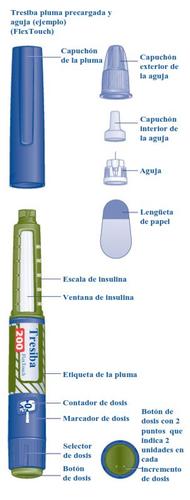
- Preparing the Pen
- Check the name and strength on the labelof your pen to ensure it contains Tresiba 200 units/ml. This is especially important if you use more than one type of insulin. If you use the wrong type of insulin, your blood sugar levels may become too high or too low.
- Remove the pen cap.
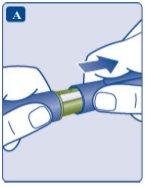
- Check that the insulin in the pen has a clear and colorless appearance.
Look through the insulin window. If the insulin appears cloudy, do not use the pen.
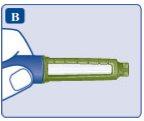
- Take a new needleand remove the paper tab.
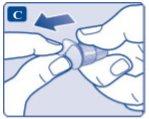
- Place the needle straight onto the pen. Screw it on until it is secure.
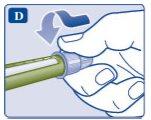
- Remove the outer needle cap and set it aside for later.You will need it after the injection to properly remove the needle from the pen.
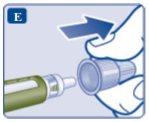
- Remove the inner needle cap and discard it.If you try to put it back on, you may accidentally stick yourself with the needle.
A drop of insulin may appear at the needle tip. This is normal, but you must still check the insulin flow.
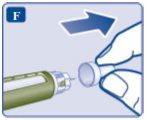
Always use a new needle for each injection.
This reduces the risk of contamination, infection, insulin loss, needle blockage, and inaccurate dosing.
Never use bent or damaged needles.
2 Checking the Insulin Flow
- Always check the insulin flow before starting.
This will help ensure you receive the full insulin dose.
- Turn the dose selector until you select 2 units.Make sure the dose counter shows 2.
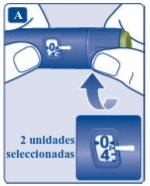
- Hold the pen with the needle pointing up.
Gently tap the top of the pena few times to make any air bubbles rise.
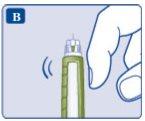
- Press and hold the dose buttonuntil the dose counter returns to 0.
The 0 must be aligned with the dose indicator.
A drop of insulin must appear at the needle tip.
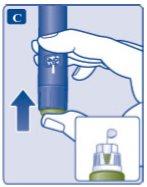
A small air bubble may remain at the needle tip, but it will not be injected.
If no drop appears,repeat steps 2A to 2C up to 6 times. If still no drop appears, change the needle and repeat steps 2A to 2C once more.
If, despite this, no insulin drop appears,discard the pen and use a new one.
Always make sure a drop appearsat the needle tip before injecting. This ensures the insulin is flowing.
If no drop appears, do notinject. The dose counter may move, but no insulin will be delivered. This could indicate that the needle is blocked or damaged.
Always check the flow before injecting.If you do not check the flow, you may receive too little or no insulin, which could result in high blood sugar levels.
3 Selecting the Dose
- Check that the dose counter shows 0 before starting.
The 0 must be aligned with the dose indicator.
- Turn the dose selector to select the dose you need,following the instructions of your doctor or nurse.
- The dose counter shows the selected dose in units. Do not recalculate the dose.
If you have selected a wrong dose, you can turn the dose selector forward or backward until you reach the correct dose.
The pen can select up to a maximum of 160 units.
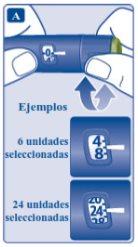
The dose selector changes the number of units. Only the dose counter and dose indicator show how many units you have selected for each dose.
You can select up to 160 units per dose. When the pen contains less than 160 doses, the dose counter stops when it reaches the number of units left.
The dose selector clicks differently when turned forward, backward, or when passing the number of units left. Do not count the pen clicks.
Before injecting the insulin, always use the dose counter and dose indicator to see how many units you have selected.
Do not count the pen clicks. If you select a wrong dose and inject it, your blood sugar levels may become too high or too low.
Do not use the insulin scale, as it only shows the approximate amount of insulin left in the pen.
4 Injecting the Dose
- Insert the needle under the skinas your doctor or nurse has taught you.
- Check that you can see the dose counter.
Do not touch the dose counter with your fingers. This could interrupt the injection.
- Press and hold the dose button until the dose counter returns to 0.
The 0 must be aligned with the dose indicator.
You may hear or feel a click.
- Keep the needle under the skin for at least 6 secondsto ensure you have administered the full dose.
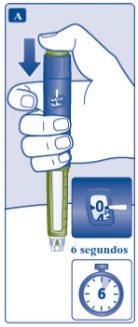
- Keep the needle and pen straight, then pull them out of the skin.
If blood appears at the injection site, press gently with a cotton ball. Do not rub the area.
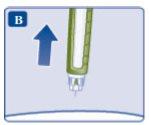
A drop of insulin may appear at the needle tip after the injection. This is normal and does not affect the dose.
Always check the dose counter to see how many units you inject.
The dose counter shows the exact number of units. Do not count the pen clicks.
Press and hold the dose button until the dose counter returns to 0 after the injection. If the dose counter stops before reaching 0, the full dose has not been administered, which could result in high blood sugar levels.
5 After the Injection
- Put the needle tip into its outer cap,placed on a flat surface, without touching the needle or the outer cap.
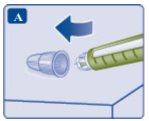
- Press the outer cap fully and carefully.
- Unscrew the needleand dispose of it carefully.
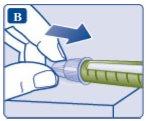
- Put the pen cap back on the pen after each use to protect the insulin from light.
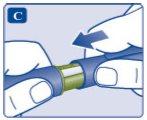
Always discard the needle after each injectionin an approved sharps container. This reduces the risk of contamination, infection, insulin loss, needle blockage, and inaccurate dosing. If the needle is blocked, do notinject insulin.
When the pen is empty, discard it withoutthe needle attached, following the instructions of your doctor, nurse, pharmacist, or local authorities. Do not throw away the used needle in household trash.
Never attempt to put the inner needle cap back on.You may stick yourself with the needle.
Always remove the needle after each injectionand store your pen without the needle attached.
This reduces the risk of contamination, infection, insulin loss, needle blockage, and inaccurate dosing.
6 How Much Insulin is Left?
- The insulin scaleshows the approximateamount of insulin left in the pen.
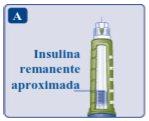
- To find out exactly how much insulin is left,use the dose counter:
Turn the dose selector until the dose counter stops.
If it shows 160, it means there are at least 160 unitsleft in the pen.
If it shows less than 160,the number indicates the amount of units left in the pen.
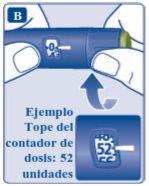
- Turn the dose selector backward until the dose counter shows 0.
- If you need more insulin than the units left in the pen, you can split the dose between two pens.
Be very careful when splitting your dose.
In case of doubt, inject the full dose with a new pen. If you split the dose incorrectly, you may inject too little or too much insulin, which could result in high or low blood sugar levels.
More Important Information
- Always carry the pen with you.
- Always carry a spare pen and new needleswith you, in case of loss or damage.
- Always keep the pen and needlesout of sight and reach of others, especially children.
- Never sharethe pen or needles with others. This could lead to infections.
- Never sharethe pen with others. Your medicine could be harmful to their health.
- People caring for patients must handle used needles with careto reduce the risk of accidental needlestick injury and infection.
Care of the Pen
Treat your pen with care. Rough handling or misuse may cause inaccurate dosing, resulting in high or low blood sugar levels.
- Do not leave the pen in a caror other location where it may be exposed to excessive heat or cold.
- Do not expose the pen to dust, dirt, or liquids.
- Do not wash, soak, or lubricate the pen.If necessary, clean it with a damp cloth and a mild detergent.
- Prevent the pen from fallingor impacting hard surfaces.
If you drop the pen or suspect it may be damaged, put a new needle on and check the insulin flow before injecting.
- Do not attempt to refill the pen.Once empty, it must be discarded.
- Do not attempt to repair the penor disassemble it.

How much does TRESIBA 200 Units/mL FlexTouch pre-filled pen solution for injection cost in Spain ( 2026)?
The average price of TRESIBA 200 Units/mL FlexTouch pre-filled pen solution for injection in January, 2026 is around 96.41 EUR. Prices may vary depending on the region, pharmacy, and whether a prescription is required. Always check with a local pharmacy or online source for the most accurate information.
- Country of registration
- Average pharmacy price96.41 EUR
- Active substance
- Prescription requiredYes
- Manufacturer
- This information is for reference only and does not constitute medical advice. Always consult a licensed doctor before taking any medication. Oladoctor is not responsible for medical decisions based on this content.
- Alternatives to TRESIBA 200 Units/mL FlexTouch pre-filled pen solution for injectionDosage form: INJECTABLE, 100 units/mlActive substance: insulin degludecManufacturer: Novo Nordisk A/SPrescription requiredDosage form: INJECTABLE, 100 U/mlActive substance: insulin degludecManufacturer: Novo Nordisk A/SPrescription requiredDosage form: INJECTABLE, 100 U/mlActive substance: insulin glargineManufacturer: Eli Lilly Nederland B.V.Prescription required
Alternatives to TRESIBA 200 Units/mL FlexTouch pre-filled pen solution for injection in other countries
The best alternatives with the same active ingredient and therapeutic effect.
Alternative to TRESIBA 200 Units/mL FlexTouch pre-filled pen solution for injection in Ukraine
Online doctors for TRESIBA 200 Units/mL FlexTouch pre-filled pen solution for injection
Discuss dosage, side effects, interactions, contraindications, and prescription renewal for TRESIBA 200 Units/mL FlexTouch pre-filled pen solution for injection – subject to medical assessment and local rules.














